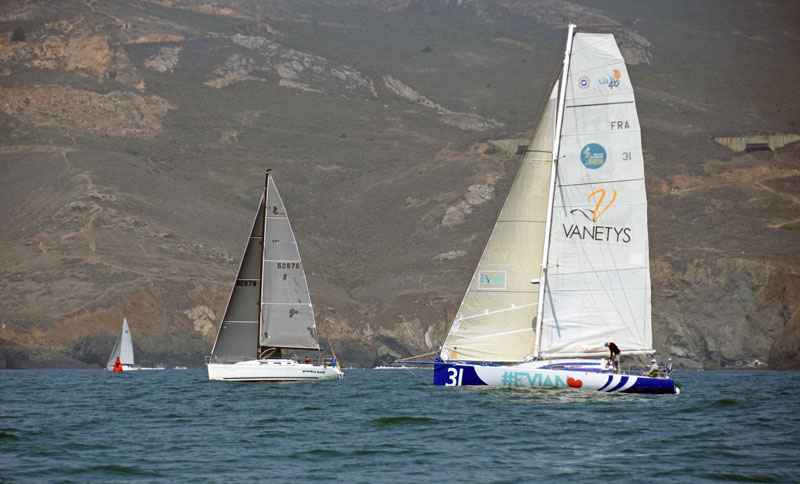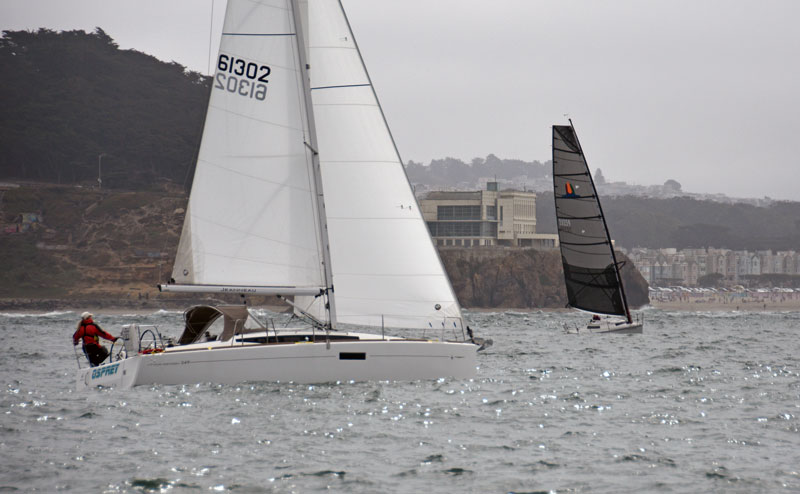
New Equipment Requirements for YRA and SSS Offshore Races
From the Yacht Racing Association of San Francisco Bay
If you’re planning to race offshore in the San Francisco Bay Area in 2024, you’ll want to take note of these changes to the offshore safety equipment requirements. They affect all coastal races run by the Yacht Racing Association of San Francisco Bay.

In their December 1 Racing Roundup email newsletter, the YRA wrote: “Offshore Racers! The 2024 SERs have been published. The Safety Equipment Requirements for Offshore Racing in 2024 are now available. These requirements are used for all YRA Offshore Races, as well as many other offshore races starting in San Francisco Bay.
“Please pay careful attention to section 3.9 AIS, as this is the biggest change for this year.”
Changes to Requirements for 2024
3.6.2 Smoke Flares no longer required.
(Changed by US Sailing in March 2023.)
3.6.4 Hand Flares
A boat shall carry three SOLAS day/night red hand or parachute flares not older than the expiration date. (SF-YRA change)
3.9 AIS
All boats shall have an AIS Transponder, sharing a masthead VHF antenna via a low loss AIS antenna splitter. An acceptable alternative is a dedicated AIS antenna that is a minimum of 0.9 meters long, mounted with its base at least 3 meters above the water, and fed with coax that has a maximum 40% power loss. US Sailing AIS requirement for Coastal is effective January 1, 2024.
Old rule: The ability to transmit an AIS signal is not required by SF-YRA but the ability to receive an AIS signal is recommended. (SF-YRA change)
For the complete updated offshore requirements, see http://yra.org/wp-content/uploads/2023/12/SER-with-SF-YRA-changes-2024.pdf. For inside-the-Bay requirements, see https://yra.org/equipmentrequirements-2.
The Singlehanded Sailing Society Follows Suit
At their season-end awards get-together yesterday afternoon at Richmond Yacht Club, Chris Case, commodore of the Singlehanded Sailing Society, confirmed what we suspected was coming. The SSS board agreed to implement the same equipment requirements for their own offshore races. These range from the short jaunt down the local coastline to Half Moon Bay to the biennial Singlehanded Transpacific Yacht Race to Hanalei, Hawaii.

The gathered sailors expressed mixed emotions and conflicting opinions. Accomplished ocean racer Greg Nelsen, a marine industry professional, mentioned that the AIS transponder installation had cost him $1,200 including tax and splitter. Chris listened to all comments and acknowledged that he heard the reactions. There may be a possibility to exempt the SSS Half Moon Bay Race from the requirement, but we think that’s unlikely to happen. As Chris put it, how would it look if there was an incident and the SSS didn’t require transponders while the YRA Half Moon Bay Race did?
As with the YRA, the new equipment requirements don’t apply to SSS in-the-Bay races, such as the Three Bridge Fiasco coming up on January 27. And if you’re just cruising the coast, even as part of an official yacht club cruise-out, the new requirements don’t apply.
2024 PHRF Certificates
PHRF applications are now available for 2024. The fee for a PHRF certificate remains $100, which includes a $50 YRA membership fee.
“For renewals with no changes, there is no form needed, simply renew online through Jibeset and a new certificate will be sent to you,” says the YRA. “If you have changes to make to your current configuration please mark the changes on your current certificate and email it to us at [email protected]. For new certificates, download the 2024 PHRF Application and email your completed application to [email protected].”

Seems like this is another example of requiring equipment that has more likelihood of creating a false sense of security and generating unneeded confusion in the fleet=having a bunch of small boats broadcasting will undermine the value of AIS with clutter. AIS was a wonderful technology when large, fast moving vessels started broadcasting their information–for once you had a good data how to negotiate transiting their paths and communicating with them by name if necessary. But a whole cluster of small boats broadcasting and setting off CPA alarms (which very likely will be turned off because of the distraction in a race situation) while they move at 6kts will make for chaos and undermine the utility. If the YRA was actually interested in offshore safety, they should require and provide some special skipper and crew education regarding the special hazards of the Farallons, the Potato Patch, Ocean Beach, etc. instead of generating more belief that rescue technology could help you if you screw up on basic seamanship and local knowledge. False priorities. I suppose this will be a boon to the race committees. Could that be what is driving this? Certainly hard to imagine it meaningfully increases safety–seems to undermine the usefulness of AIS rather than provide useful input.
Disabling CPA alarms does not preclude the safe use of AIS.
Hi Ray, thanks for your comments. I wonder how the use of AIS would be a boon to race committees?
In my appeal to the SSS board (which was ignored), I gave them the race entry numbers for the local, shorthanded ocean races. These were easily obtained from Jibeset. Both OYRA’s shorthanded division and SSS’s Half Moon Bay, Farallones and Drake’s Bay races show the same trend: After recovering to pre-Covid levels in 2021, entries dropped by 30-33% from 2021 to 2023. Now skippers considering entering these races have been hit with an additional $800-$1,200 equipment requirement. It’s true we can sail out in the ocean any time we want without having most of this gear, but these are races. It costs $300 just for the OYRA entry fees. It’s simply not worth it if there are only a couple of boats left to race against. And FWIW, I already have an AIS transponder.
I am assuming one parachute and two hand helds satisfies the three item requirement. I don’t want there to be a misunderstanding.